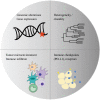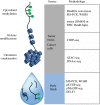Contribution of Genomics to the Surgical Management and Study of Oral Cancer
- PMID: 33846893
- PMCID: PMC8460589
- DOI: 10.1245/s10434-021-09904-0
Contribution of Genomics to the Surgical Management and Study of Oral Cancer
Abstract
Background: Oral squamous cell carcinoma (OSCC) is the most frequent type of tumor arising from the oral cavity. Surgery is the cornerstone of the treatment of these cancers. Tumor biology has long been overlooked as an important contributor to the outcome of surgical procedures, but recent studies are challenging this concept. Molecular analyses of tumor DNA or RNA provide a rich source of information about the biology of OSCC.
Methods: We searched for relevant articles using PubMed. We examined in particular the prospect of applying molecular methods for minimally invasive exploration of OSCC biology.
Results: We examined five potential applications of genomics to the surgical management and study of OSCC: i) assessing oral potentially malignant lesions; ii) tumor staging prior to surgery; iii) predicting postoperative risk in locally advanced tumors; iv) measuring minimal residual disease and optimizing the longitudinal monitoring of OSCC; and v) predicting the efficacy of medical treatment.
Conclusions: Genomic information can be harnessed in order to identify new biomarkers that could improve the staging, choice of therapy and management of OSCC. The identification of new biomarkers is awaited for better personalization of the surgical treatment of OSCC.
© 2021. The Author(s).
Conflict of interest statement
Florian Clatot received honoraria for expert testimony from Merck Serono, MSD, and BMS. The remaining authors have no conflicts of interest.
Figures



References
Publication types
MeSH terms
Substances
LinkOut - more resources
Full Text Sources
Other Literature Sources
Medical

